Michigan is a state known for its water and natural areas with many different habitats to explore. But did you know that it’s also home to over 450 species of birds?
In the winter, it’s not uncommon to find snow-covered trees and red cardinals in your backyard. In summer, you might see a blue jay perched on top of your fruit basket or an oriole stealing nectar from one of your flowers.
This blog post will take a look at the 25 most common birds in Michigan. You’ll learn about their habitat, diet, and much more!
1. Northern Flicker
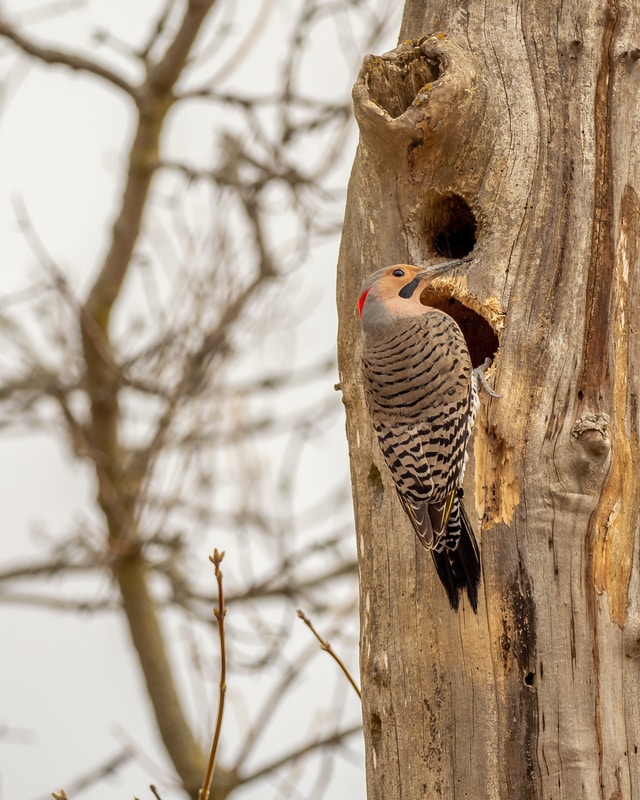
Northern Flicker is a rather large member of the woodpecker family that measures between roughly 7 and 13 inches in length.
Both males and females have yellow undersides with dark spots, while their chests are reddish-orange with bold black bars. Northern Flickers prefer open areas to build their nests, but they’ll take over an old nest box or cavity if necessary.
Northern Flicker diets are varied and include fruits, berries, seeds, nectars, ants, termites, beetles, millipedes and earthworms. They’re attracted by suet feeders during the winter months when their preferred food sources become scarce.
2. Downy Woodpecker
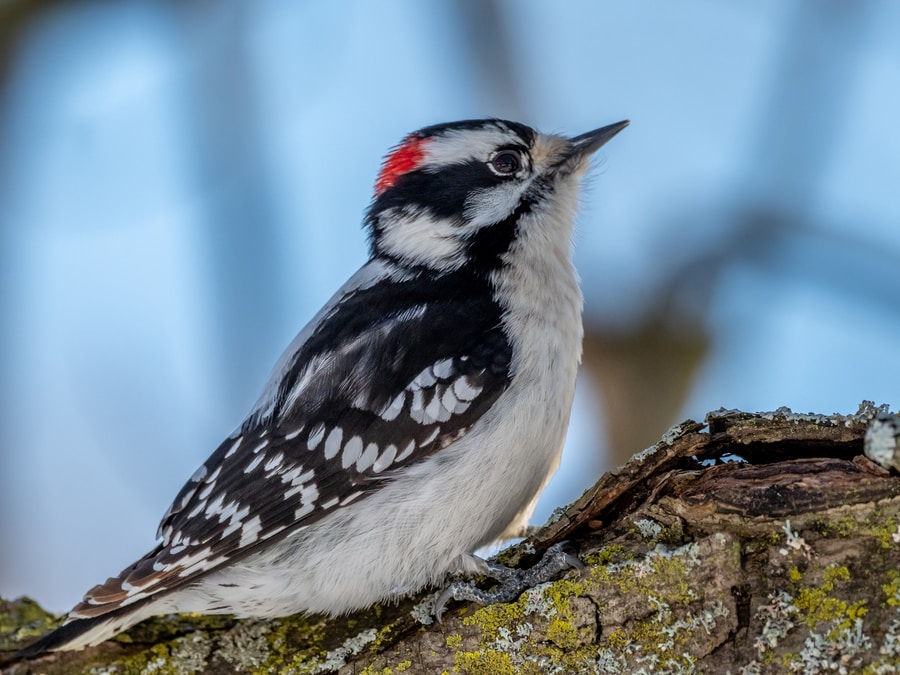
Downy Woodpecker is a small bird that measures just 5 inches from beak to tail. The male has a bright red spot on the back of its head, while the female lacks this marking and is more greenish-gray in color.
Downy Woodpeckers like to nest in protected areas such as tree cavities or vines.
Downy Woodpecker eats insects and larvae found in soft-barked trees such as maple, elm, birch and sycamore. They’ll also eat fruits and berries if they become available in the summer months.
3. Red-bellied Woodpecker
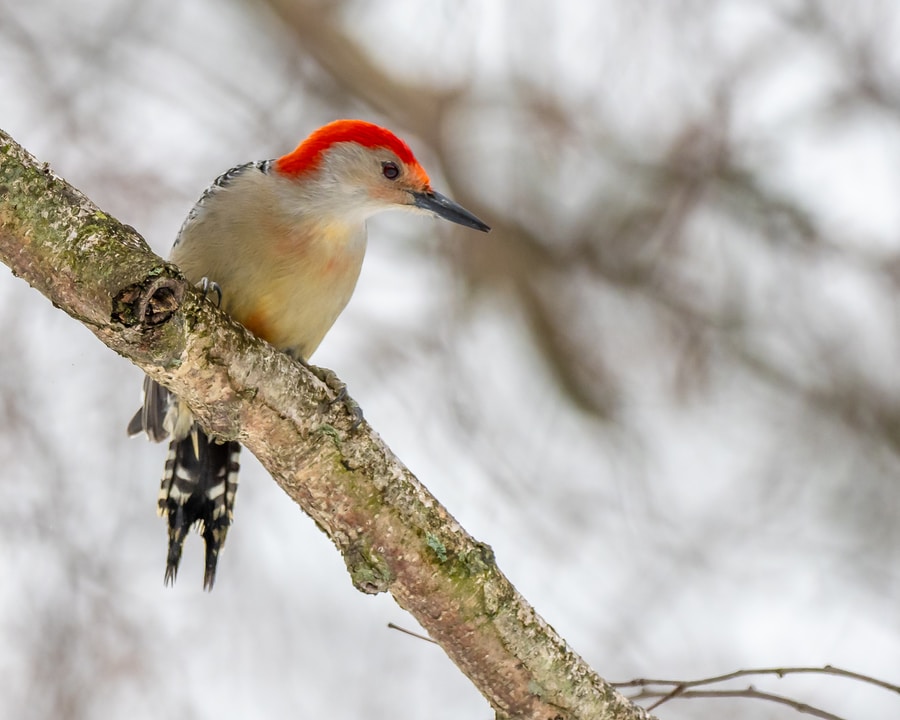
Red-bellied Woodpecker is a similar size to the Downy Woodpecker at around 5 inches long.
The male has a red patch of color on the belly, while females and juveniles have plain bellies instead.
Red-bellied Woodpeckers prefer woodland areas with open understories and places suitable for nesting.
Red-bellied Woodpecker feeds mainly on insects and other invertebrates, favoring the larvae of wood-boring insects such as carpenter ants. They also eat fruits and berries during summer months when they become available.
4. American Goldfinch
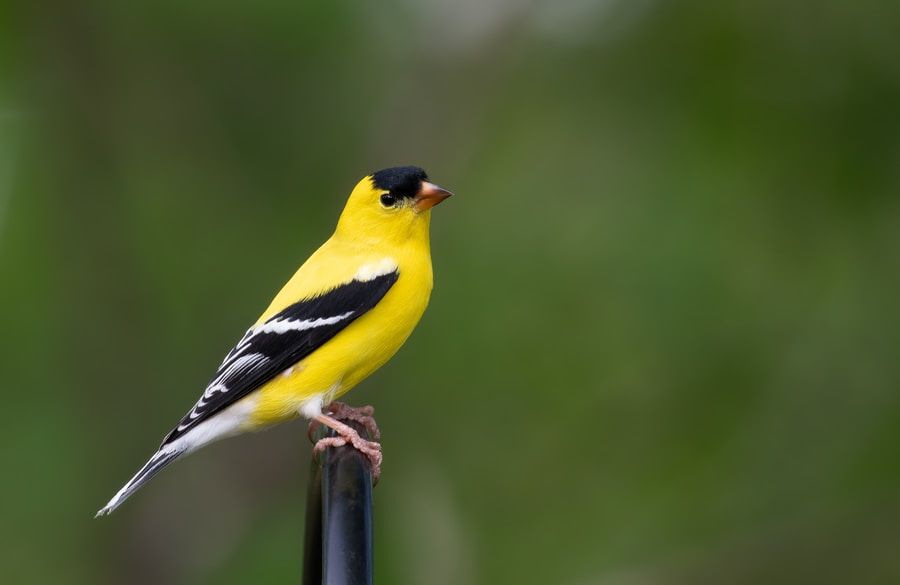
American Goldfinch is one of the most common birds you will find in Michigan.
It measures around 6 inches in length and has a long gold-colored stripe on top of its head. The male also has a black cap with yellow behind it, while the female lacks these markings.
American Goldfinch is found in many different habitats including residential areas such as birdfeeders and gardens. They feed primarily on seeds, but during the summer months they’ll supplement their diet with insects and nectar.
American Goldfinch flocks can be very large during the winter, sometimes numbering over 20,000 birds! During the spring and fall migrations, you might see smaller groups flying through your neighborhood.
5. Northern Shoveler

Well, Northern Shoveler is a widespread duck species, including Michigan. Both male and female have a curved bill that resembles a shovel, which is how they got their name!
Their bodies measure between 20 and 28 inches in length, with males being slightly larger. Northern Shovelers live throughout the North America, preferring shallow ponds or marshes for nesting sites.
Northern Shovel diets includes plant matter, insects, mollusks and small fish.
6. Mourning Dove
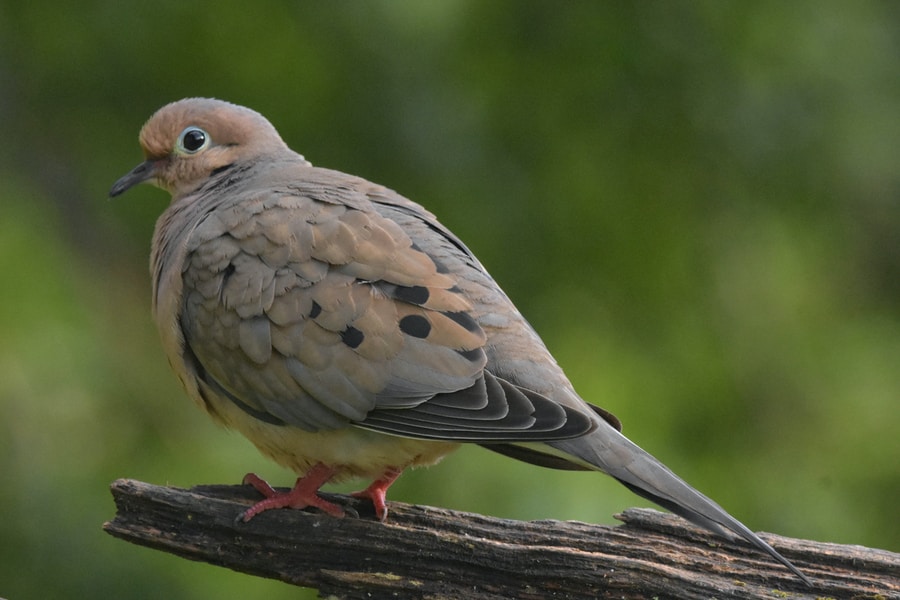
Mourning Dove is also known by its scientific name of Zenaida Macroura. It’s the most widespread North American dove species and is found in all 48 contiguous states.
Mourning Doves are rather large birds, measuring between 10 and 14 inches from beak to tail. Males have a black spot on their neck, while females don’t have this marking.
They eat mostly seeds, but will supplement their diet with fruit and insects during the summer months. Mourning Doves live in most habitats including open fields, woodland edges or residential areas.
7. American Crow
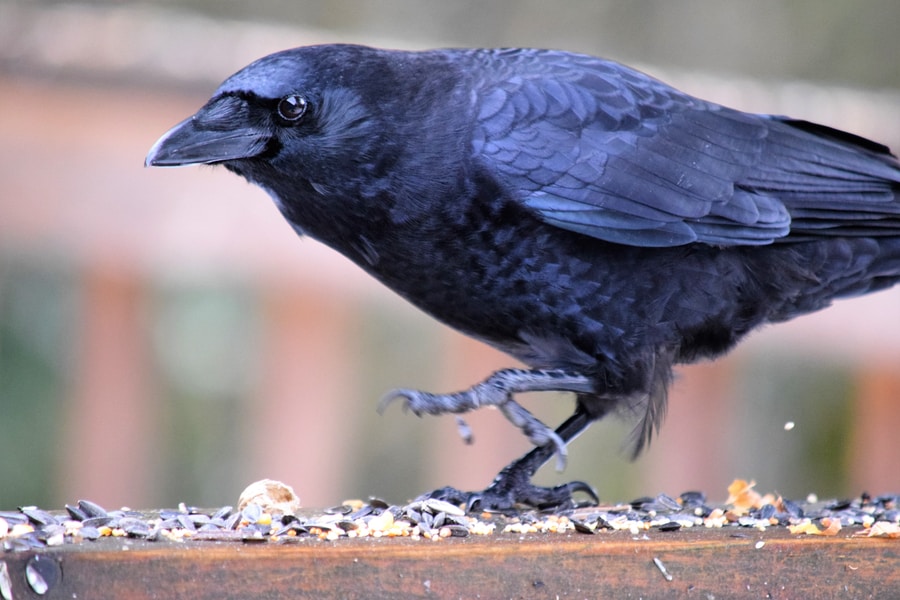
The American Crow is one of Michigan’s most common birds. It measures about 16 inches long and has a wingspan of nearly 4 feet.
The crow’s scientific name is Corvus Brachyrhynchos. Both sexes are alike, with black feathers and a solid wedge-shaped tail.
American Crows live in almost every habitat found in Michigan. They like open spaces to forage for their food, but will sometimes venture into residential areas to find food scraps or birdfeeders filled with seeds.
American Crows have adapted well to living around people and will often hunt the same prey, including mice, as hawks and owls do. Scientists estimate there are at least 30 million crows in North America!
8. Song Sparrow
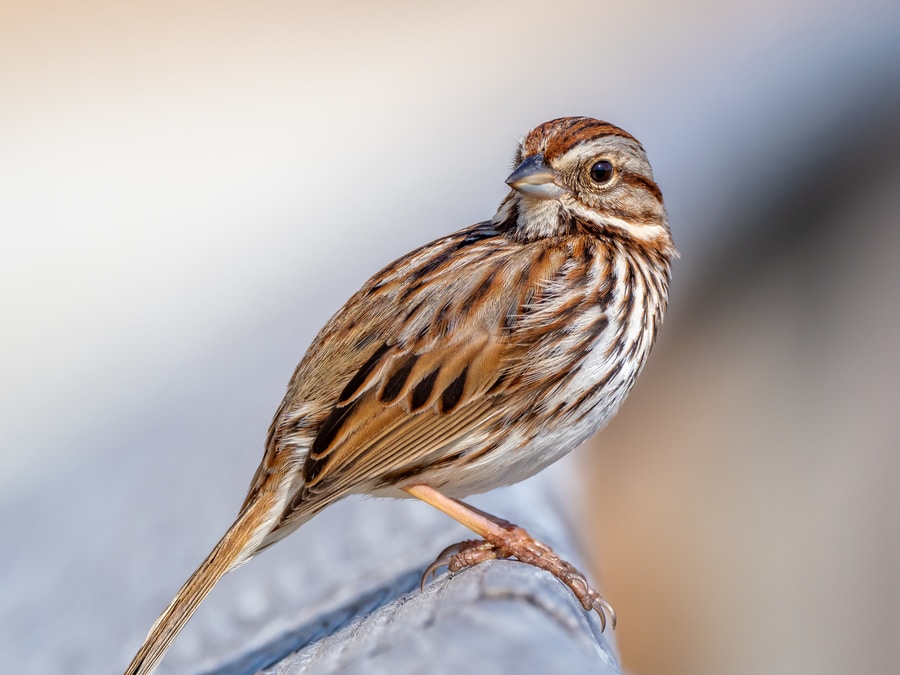
The song sparrow is a common bird found throughout Michigan and measures between 8 and 9 inches long.
The species name of Melospizla melodia comes from the fact that they can produce many different sounds, hence their nickname of “Song Sparrow”.
Males and females look alike with grey-brown feathers on their upper body and pale yellow undersides.
Song Sparrows eat a variety of foods such as seeds, berries and insects. Song sparrows live in many habitats including fields, open woodland or residential yards. They will eat just about anything when it’s available!
9. White-breasted Nuthatch
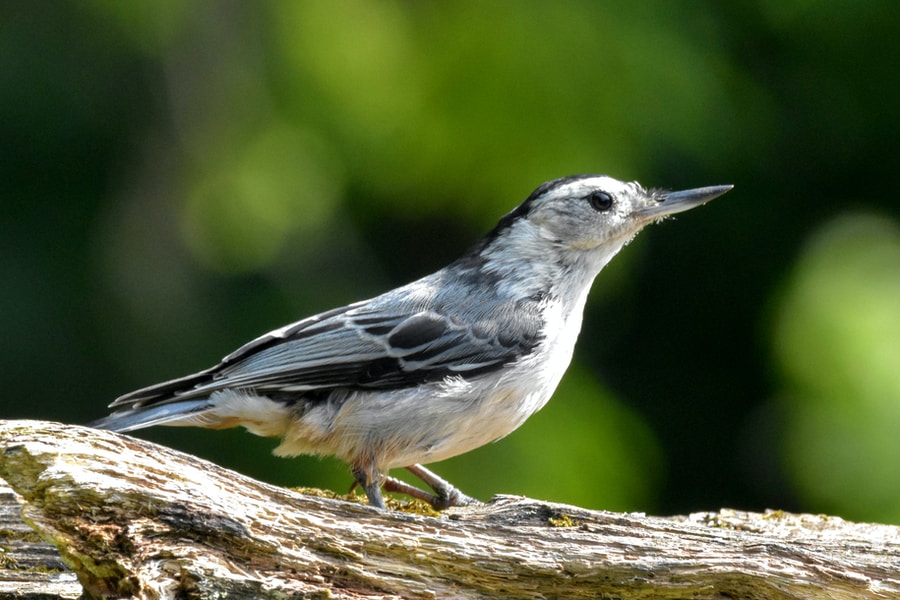
White-breasted Nuthatch is a common bird in Michigan and can often be seen foraging for food on tree trunks.
The species name Sitta carolinensis describes this action, since nuthatch comes from the word “nid” which means “to nest”.
Nuthatches are small birds measuring between 4.5 and 5.5 inches long. Males are slightly larger than females, but both have white undersides with dark bands on their neck, back and wings. White-breasted Nuthatches can be found in any habitat that features mature trees!
10. Ross’s Goose
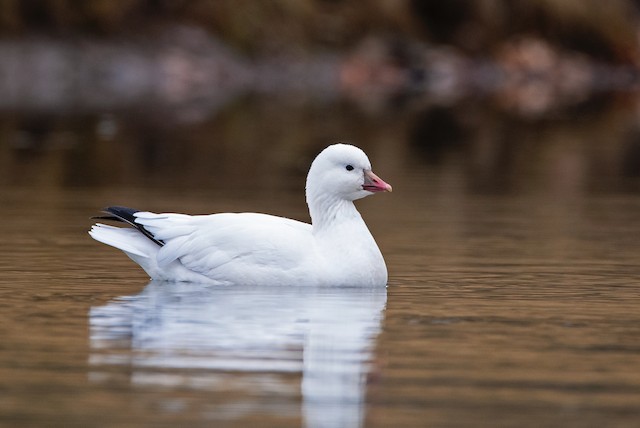
Ross’s Goose is also one of common bird of Michigan and can be found in small numbers during migration. They were first recorded in the state in 1960 and the total population is estimated around 500 birds.
Ross’s geese are very similar in appearance to Canada Geese, but they are smaller with white heads that contrast sharply with black stripes running from their bills to the back of their necks.
They also do not migrate to the same areas as their larger relatives. Ross’s Geese can be found in wetlands on small ponds and lakes.
Ross’s Geese measure between 25 and 29 inches long and typically weigh between 6 and 9 pounds.
11. Canada Goose
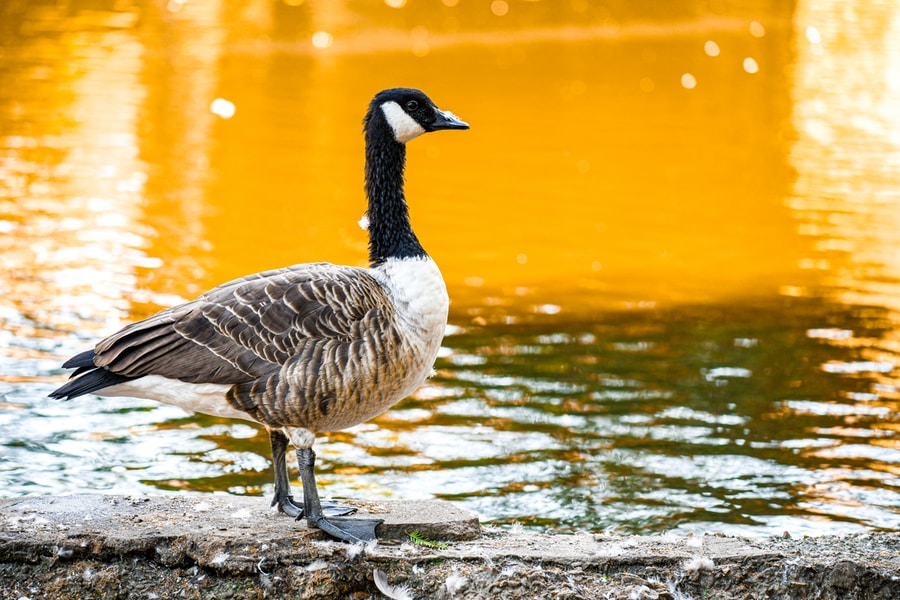
Canada Geese are one of the largest birds in North America and can be seen year-round in Michigan. They weigh between 6 and 14 pounds, with males being slightly larger than females.
Male Canada Geese have white patches on their necks, while the smaller females tend to have browner feathers. Canada geese are easily identified by their “honking” call, which they use to communicate with each other.
Canada Geese are not endangered and populations have actually increased in recent years, partially because people often feed them at parks or put out birdfeeders filled with grain. This has changed the way this species interacts with people!
12. Pine Siskin
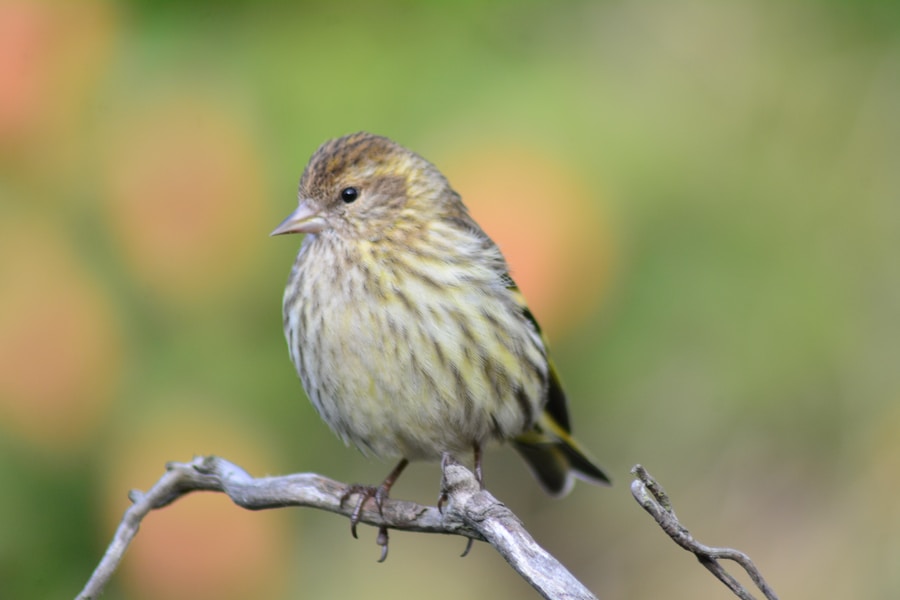
The pine siskin is a finch native to North America. The bird is a tiny, narrow-winged finch with a short, wide bill.
Pine Siskins have olive-green upperparts and yellow underparts with two white wing bars. In North America, they are permanent residents in the southern half of their range; northern birds migrate farther south as it gets colder.
They eat a variety of foods, especially seeds and berries from weeds such as coneflower. They will sometimes eat insects too!
Pine siskins are some of the earliest migrants in the fall and stay in Michigan until winter is almost over. When they build their nests, pine siskins choose a protected area like a cliff face or stump.
13. Black-capped Chickadee

Black-capped Chickadees are the most common of the three species of chickadee found in Michigan. They live throughout North America and can be identified by their black cap and bib and white cheeks.
Chickadees make a very distinct “chick-a-dee” sound; it is often heard near large woods and parks on warm afternoons.
Chickadees eat a variety of foods, but they especially enjoy seeds from conifers such as pine trees. In addition to this food source, chickadees also eat insects and spiders!
The Black-capped Chickadee nests in deciduous or mixed forests, making its home in a cavity found in a tree. Their nests are usually made from twigs and lined with hair, feathers or moss.
14. Cooper’s Hawk
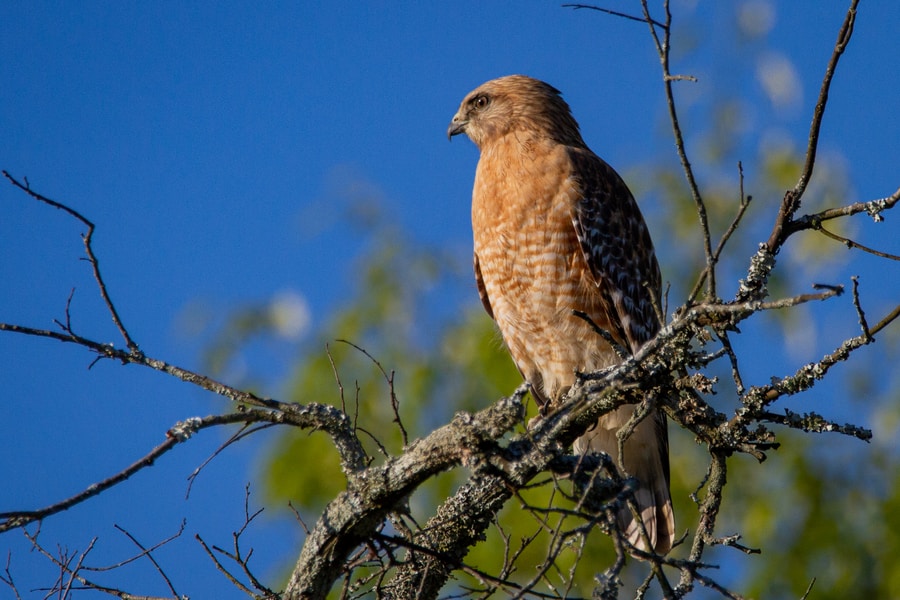
Cooper’s Hawks are birds of prey with long tails and broad wings, making them well-equipped to fly quickly in pursuit of their prey. They are found throughout the United States, Mexico, Central America and parts of South America.
Cooper’s Hawks are dark brown on top with pale undersides that are barred with black. Their feathers are lightly streaked in appearance
They eat a variety of foods, including birds and small mammals such as chipmunks or mice!
Cooper’s Hawks typically nest on the top of trees and they will often return to the same nesting area year after year.
15. American Black Duck
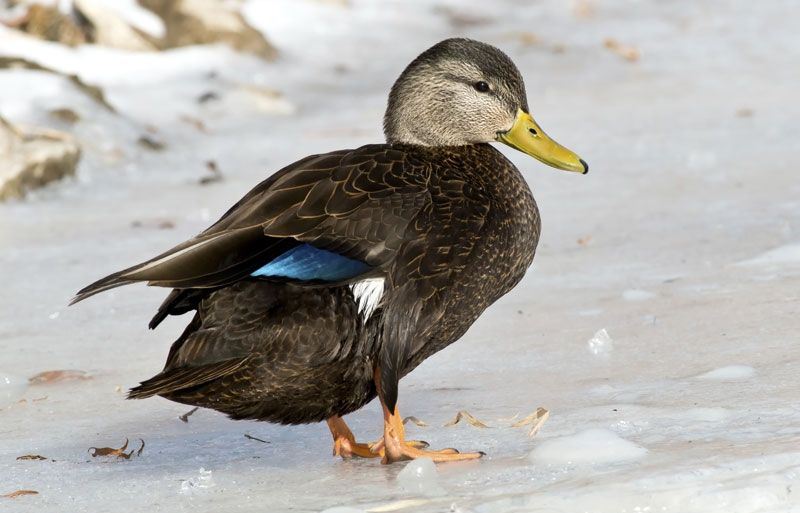
Do you know Daffy Duck from Looney Tunes? You might be surprised to learn that American Black Ducks look very similar. In fact, Daffy Duck is an american black duck.
They are mainly black with large white patches on the neck and back, making them easy to identify by color alone.
American Black Ducks are members of the duck family; they have wings for flight, but their tails are short and round like other diving ducks.
These ducks live in or near fresh water ponds, large rivers or swamps. These areas typically have dense vegetation that the ducks use for protection and nesting material.
American Black Ducks make their nests on top of plants like cattails; they will also look for protected areas like holes along riverbanks.
16. Barn Owl

Tyto alba is the scientific name for the barn owl; it means “white-eyed night-roaming hunter”.
The barn owls back and wings are covered in soft brown and white feathers, while their chest is a light tan color.
Though these birds look somewhat like hawks or eagles, they don’t have any sharp claws – which explains the phrase “all bark and no bite”.
Barn owls hunt rodents like mice, rats or voles; they will either catch them on the ground or snatch them right off of a branch. Barn owl pairs will travel up to 10 miles to find food!
The barn owl makes its home in open areas with trees nearby. They can be found in grasslands, farmland or forests; their nests are made on the ground out of sticks.
17. Tufted Titmouse
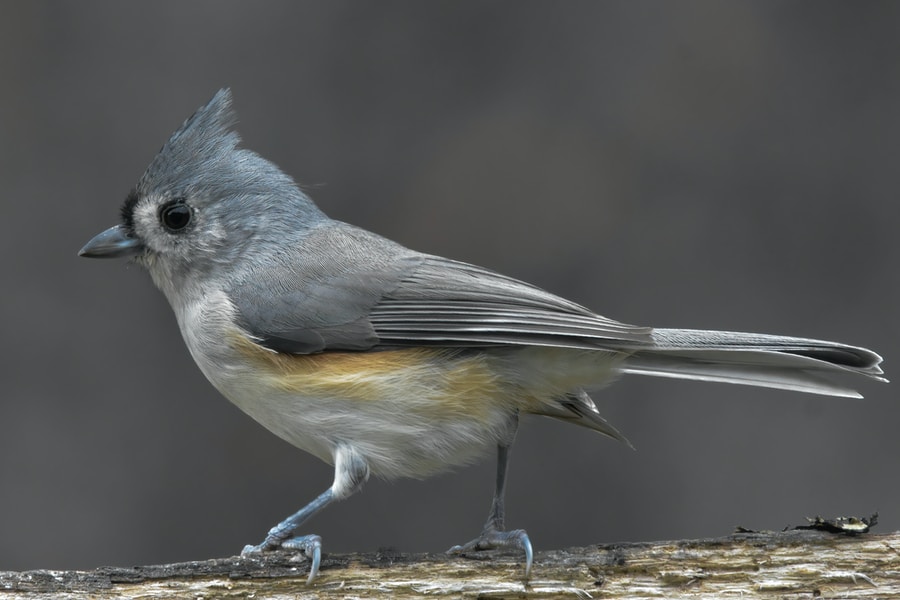
The tufted titmouse has a small black cap and crest on its head, which look like tiny feathers sticking straight up.
Their coloring is primarily gray with a white belly. Tufted Titmice have round wings and a short tail with dark streaks.
These birds eat insects or seeds from trees such as oak, maple and hickory. Titmice live in deciduous and mixed forests or swampy areas like cattails and red maple trees.
Titmice make their nests from twigs, leaves and grasses; they are found on the ground or near it. Titmice often use natural cavities or abandoned woodpecker holes for their home.
18. Northern Cardinal
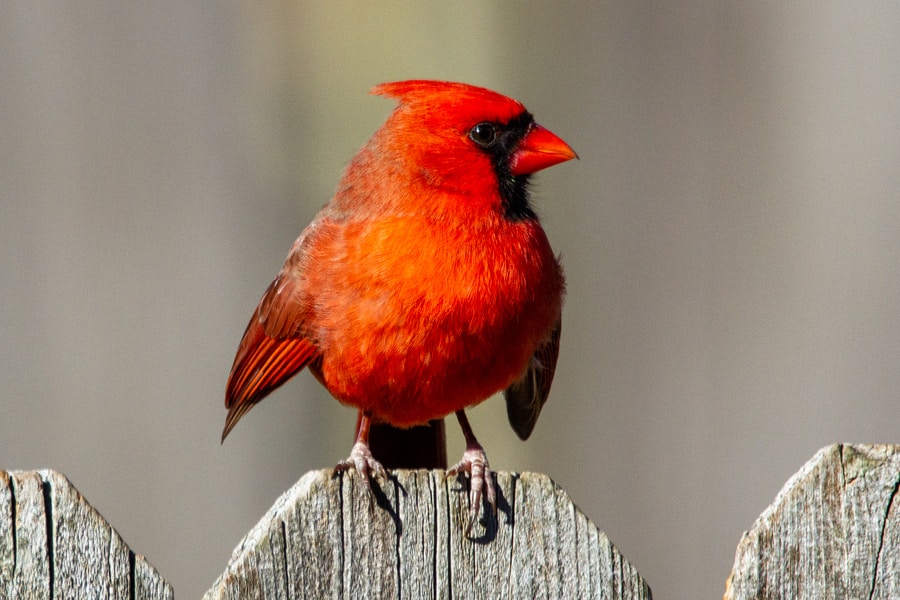
Northern Cardinal, also known as a red bird, has a scarlet body with a black face mask.
These beautiful birds have a very distinct melodic song that sounds like “cheer-up cheer-up cheer up!”.
Cardinals are found year round east of the rocky mountains and north into Canada. They especially love areas with dense shrubbery or thick vegetation along the forest border.
During the winter months, cardinals will also live in residential areas; they love to hang out around fruit trees and people’s gardens!
Cardinals make their nests close to the ground on a tree branch or fence post. They often use dense vines for climbing while looking for a piece of bark to land on.
19. Dark-eyed Junco
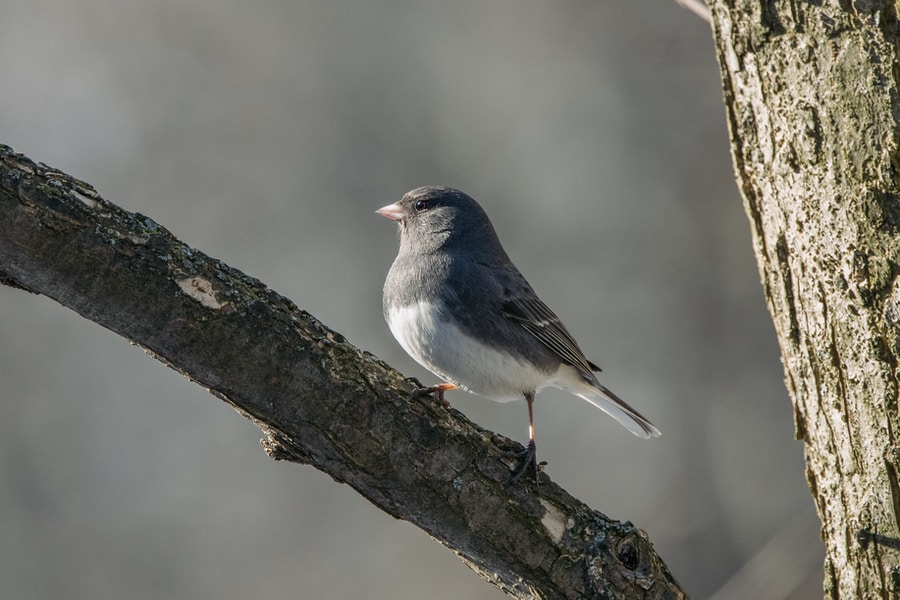
As the name implies, this bird has very dark eyes and its feathers are mainly gray, brown and white.
The junco’s tail alternates between black and white; it is thick with a very round shape.
Juncos love to eat the seeds from conifer trees such as balsam fir and red spruce. They also like berries!
Juncos are found throughout eastern North America, they can also be seen in the northern United States.
These birds live in mountainous or hilly areas with dense coniferous forests or evergreen trees. Juncos will take shelter and their nests under large branches and rocks.
20. Blue Jay

The blue jay is a member of the Corvidae family, which includes birds like crows and ravens.
Blue jays are known for their bright blue coloring, which can be seen at almost any time of day, including during the night!
These birds are year round residents in Michigan; they especially love wooded areas with fruit trees. Blue jays are social birds, which means they love to hang out in groups!
Blue jays make their nests in holes or cavities of conifer or deciduous trees. They will use small twigs to line the bottom of these cavities.
21. American Robin
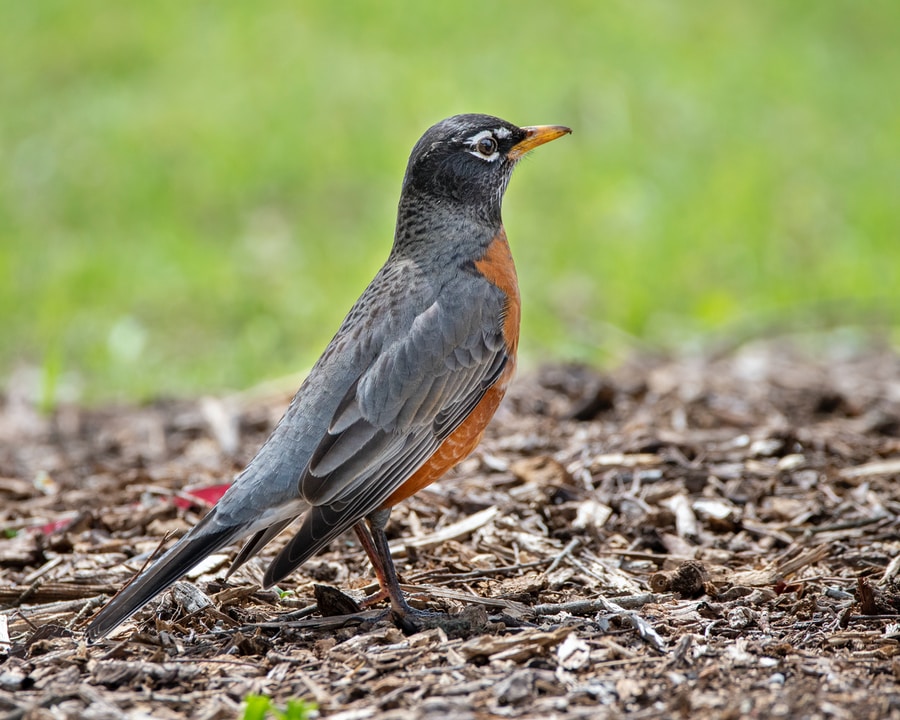
The American Robin is a songbird in the thrush family.
These birds are dull gray in color with a white belly and red-brown breast.
Robins live all across North America year round. They can even be found in southern Canada during the summer months!
During the winter months when food is scarce, they will come down to areas near people’s homes to search for food.
Robins are ground feeders who eat worms, insects or snails. They also love to eat berries! Robins make their nests on the ground out of twigs and leaves.
22. Snow Goose
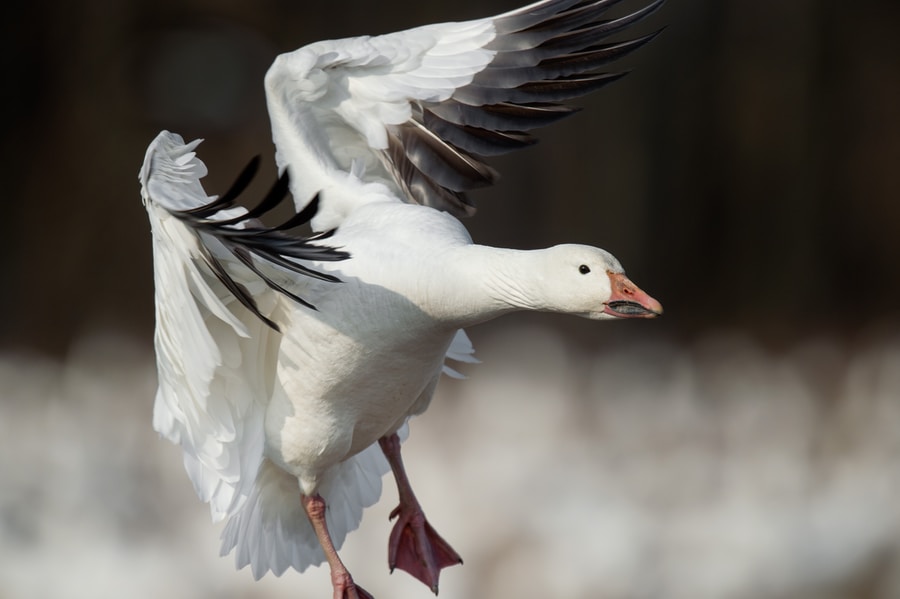
Snow Goose is native to North America, and they can be found all across the continent during the winter months.
These birds have a white body with black tips on their wings and tail. Their head is mostly pink with a blue crown surrounded by white feathers.
Snow Geese live in grassy, flat areas for most of the year, especially fields or meadows near lakes, rivers or ponds.
These birds feed on grasses, seeds or grain; they may even eat insects or small fish when swimming around in fresh water lakes
These birds are pure white with black wing tips. They have an orange bill with a black end.
Snow geese live in open or semi-open areas where grasses, sedges and wheat can be found for them to eat.
23. American Wigeon
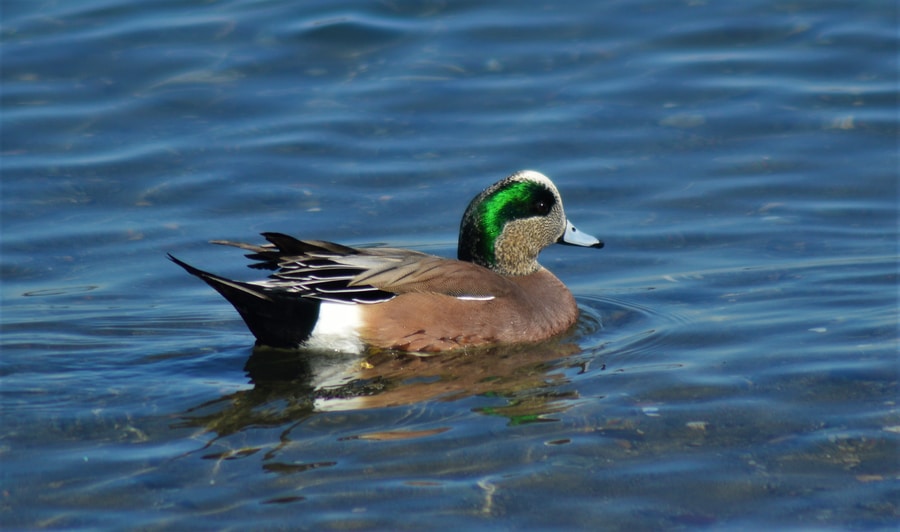
American Wigeon is a species of dabbling duck that can be found across North America.
Their feathers are brown and black with a blue-gray head and white belly.
These birds live in large freshwater lakes or reservoirs, as well as marshes or swamps near rivers and ponds.
American Wigeon feed on grasses and aquatic vegetation; they also enjoy munching on insects, small crabs and snails.
American Wigeon live in open areas with water nearby. They often migrate during the winter months to avoid snow or freezing conditions.
24. Chimney Swift
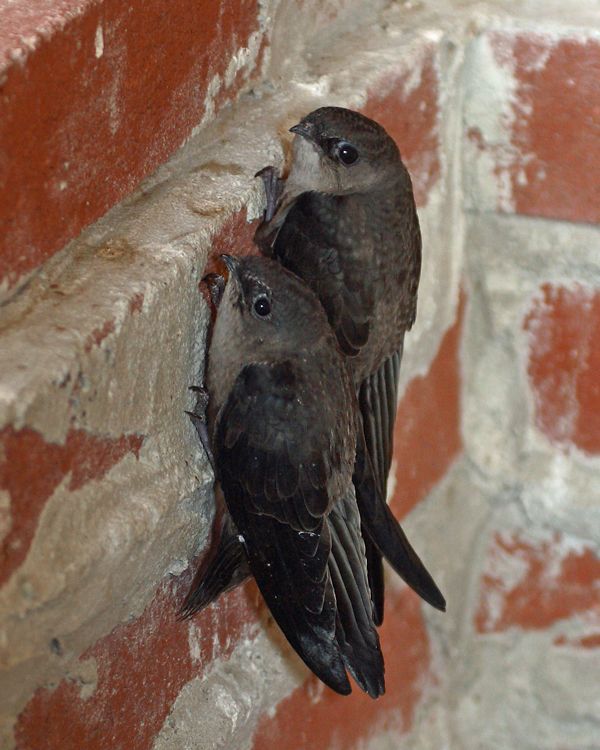
Chimney Swift got their name because they make their nests inside chimneys. They are also one of the most common swift species in Michigan. You can found Chimney Swift all across North America, even in southern Canada during the summer months!
These birds are brown with darker undertones that get lighter near their bellies. Their wings are long and slender with a fork-shaped tail.
Chimney swifts feed on flying insects; they love to eat flies, wasps, bees, and other pests!
Chimney swifts are found in open areas near cliffs, waterfalls or rivers with wide openings where insects can take shelter. They also live near buildings including homes, factories and churches because they need a quick escape route for their nests.
25. Red-winged Blackbird
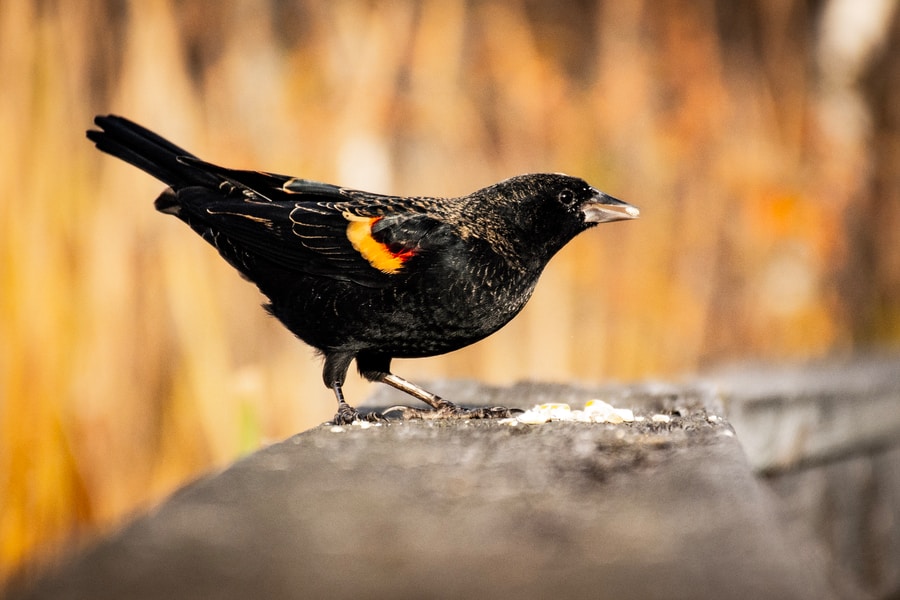
As the name suggest, the Red-winged Blackbird has a bright red-copper coloring on its wing and tail feathers.
These birds are found throughout the eastern and midwestern part of North America, but their ranges may vary during the year depending on migration patterns or weather conditions.
Red-Winged blackbirds prefer grassy fields near shallow lakes, ponds or marshes for their habitat.
Red-winged Blackbirds make their nests in tall grasses, reeds or cattails. They will often use reeds to line the bottom of their nests.
These birds are cavity nesters so they will choose any place that has an opening for them to build their nests on. They also have a high tolerance for humans so they are commonly seen around people’s homes, parks and golf courses.